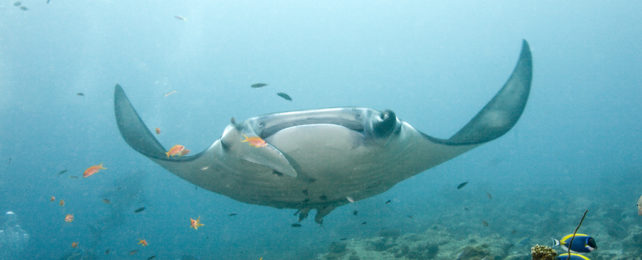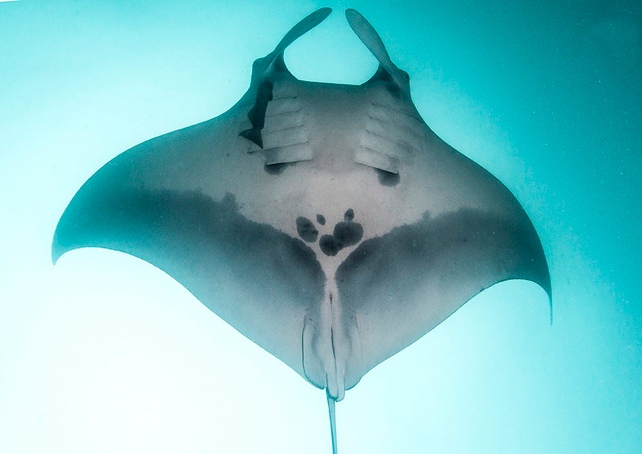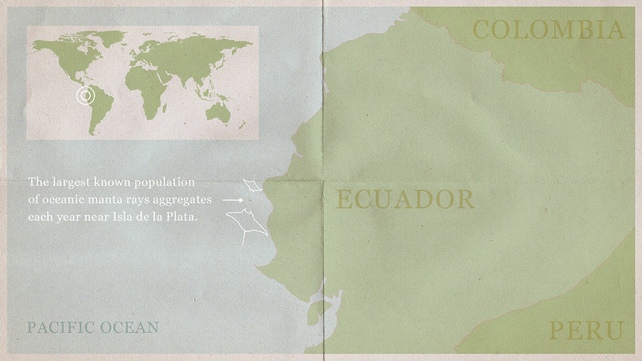Scientists Discover a Giant Manta Ray Population, 10 Times Bigger Than Any Other
Nature16 November 2022
By David Nield

(Michele Westmorland/Corbis Documentary/Getty Images)
With so many species under threat due to human activity and climate change, it's encouraging to hear about one population that's doing very well for itself: a group of more than 22,000 oceanic manta rays (Mobula birostris) off the coast of Ecuador.
That estimated population size is more than 10 times the numbers thought to be in other regions, and conservationists are hoping that this "unprecedented" community of manta rays can offer some clues about the conditions that the fish find favorable.
In 2019, oceanic manta rays were reclassified as endangered on the IUCN Red List of Threatened Species, with commercial fishing the largest threat to the species – whether that's through direct targeting or unintentional bycatch.

Oceanic manta ray. (Michel Guerrero/Proyecto Mantas Ecuador FMME)
"It's clear that something different is happening here," says quantitative ecologist Joshua Stewart, from Oregon State University. "This is a rare story of ocean optimism. In other regions, we typically have population estimates of 1,000 to 2,000 animals, which makes this species very vulnerable."
While it's clear oceanic manta rays are vulnerable, it's not easy to study and monitor these animals: they spend a lot of time in hard-to-access offshore locations, and their patterns of movement can be unpredictable as well.
Since the late 1990s, scientists have been keeping tabs on this particular group of manta rays in coastal Ecuador. For this latest estimate, researchers used more than a decade's worth of photos and observations taken out in the field between 2005 and 2018 to estimate a current population of above 22,000.

Map of location where oceanic manta rays congregate. (Oliver Day/Oregon State University)
That identifies this Isla de la Plata region as something of a hotspot for these fish. The team thinks that a plentiful supply of food could be one of the reasons the population size has grown, with cold, nutrient-rich water rising up from the depths and delivered on ocean currents providing a steady stream of zooplankton snacks.
"While there is good news about this population, it is a cautionary tale," says Stewart. "Manta rays appear to be sensitive to environmental disruptions such as changes to ocean temperatures and food availability."
"They will likely be impacted by a warming climate if upwelling strength and the abundance of food changes alongside ocean temperatures."
Long-term surveys like this are important because they give scientists a better idea of population levels around the world. Estimates of abundance and averages are extensively used to estimate population status, so it's crucial that outliers such as this group of M. birostris are factored in.
The more accurate the data, the more targeted conservation efforts can be. While capturing manta rays in this part of the world is now illegal, issues such as bycatch, fishing net entanglement and strikes from vessels remain a problem, besides climate change – many fish were observed to have injuries or scars during the research period.
And the study is also a success story for citizen science as well as oceanic manta rays. One of the main reasons that the population could be assessed (and more than 2,800 fish could be individually identified in more than 3,300 images) is because of photos submitted by scuba divers in the area.
Scientists identify individual manta rays in the images by the unique spot pattern on their belly, similar to a human fingerprint or the white spots on whale sharks. This allows researchers to count, track and monitor manta rays over time. Based on re-sightings and ray numbers, they can also estimate population size.
"Many of the photos used in our study were contributed by recreational divers who became citizen scientists when they snapped photos of manta rays," says marine researcher Kanina Harty, from The Mantra Trust in the UK.
"We get a huge amount of information about each animal just from these photographs."
The research has been published in the Marine Ecology Progress Series.
Thanks to: https://www.sciencealert.com/scientists-discover-a-giant-manta-ray-population-10-times-bigger-than-any-other
Nature16 November 2022
By David Nield

(Michele Westmorland/Corbis Documentary/Getty Images)
With so many species under threat due to human activity and climate change, it's encouraging to hear about one population that's doing very well for itself: a group of more than 22,000 oceanic manta rays (Mobula birostris) off the coast of Ecuador.
That estimated population size is more than 10 times the numbers thought to be in other regions, and conservationists are hoping that this "unprecedented" community of manta rays can offer some clues about the conditions that the fish find favorable.
In 2019, oceanic manta rays were reclassified as endangered on the IUCN Red List of Threatened Species, with commercial fishing the largest threat to the species – whether that's through direct targeting or unintentional bycatch.

Oceanic manta ray. (Michel Guerrero/Proyecto Mantas Ecuador FMME)
"It's clear that something different is happening here," says quantitative ecologist Joshua Stewart, from Oregon State University. "This is a rare story of ocean optimism. In other regions, we typically have population estimates of 1,000 to 2,000 animals, which makes this species very vulnerable."
While it's clear oceanic manta rays are vulnerable, it's not easy to study and monitor these animals: they spend a lot of time in hard-to-access offshore locations, and their patterns of movement can be unpredictable as well.
Since the late 1990s, scientists have been keeping tabs on this particular group of manta rays in coastal Ecuador. For this latest estimate, researchers used more than a decade's worth of photos and observations taken out in the field between 2005 and 2018 to estimate a current population of above 22,000.

Map of location where oceanic manta rays congregate. (Oliver Day/Oregon State University)
That identifies this Isla de la Plata region as something of a hotspot for these fish. The team thinks that a plentiful supply of food could be one of the reasons the population size has grown, with cold, nutrient-rich water rising up from the depths and delivered on ocean currents providing a steady stream of zooplankton snacks.
"While there is good news about this population, it is a cautionary tale," says Stewart. "Manta rays appear to be sensitive to environmental disruptions such as changes to ocean temperatures and food availability."
"They will likely be impacted by a warming climate if upwelling strength and the abundance of food changes alongside ocean temperatures."
Long-term surveys like this are important because they give scientists a better idea of population levels around the world. Estimates of abundance and averages are extensively used to estimate population status, so it's crucial that outliers such as this group of M. birostris are factored in.
The more accurate the data, the more targeted conservation efforts can be. While capturing manta rays in this part of the world is now illegal, issues such as bycatch, fishing net entanglement and strikes from vessels remain a problem, besides climate change – many fish were observed to have injuries or scars during the research period.
And the study is also a success story for citizen science as well as oceanic manta rays. One of the main reasons that the population could be assessed (and more than 2,800 fish could be individually identified in more than 3,300 images) is because of photos submitted by scuba divers in the area.
Scientists identify individual manta rays in the images by the unique spot pattern on their belly, similar to a human fingerprint or the white spots on whale sharks. This allows researchers to count, track and monitor manta rays over time. Based on re-sightings and ray numbers, they can also estimate population size.
"Many of the photos used in our study were contributed by recreational divers who became citizen scientists when they snapped photos of manta rays," says marine researcher Kanina Harty, from The Mantra Trust in the UK.
"We get a huge amount of information about each animal just from these photographs."
The research has been published in the Marine Ecology Progress Series.
Thanks to: https://www.sciencealert.com/scientists-discover-a-giant-manta-ray-population-10-times-bigger-than-any-other






 Sat Mar 23, 2024 11:33 pm by globalturbo
Sat Mar 23, 2024 11:33 pm by globalturbo

